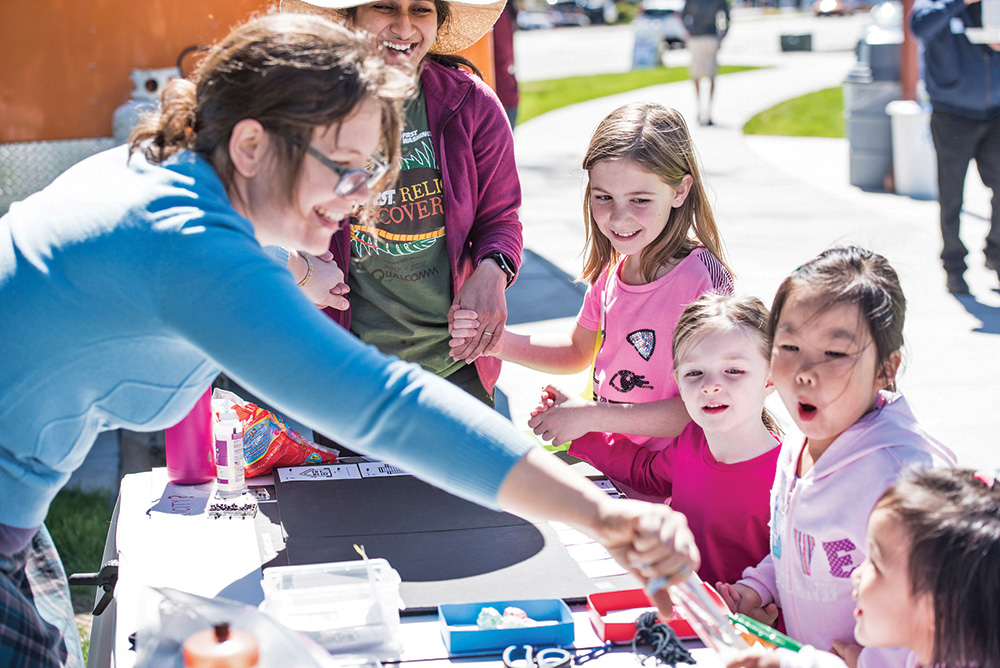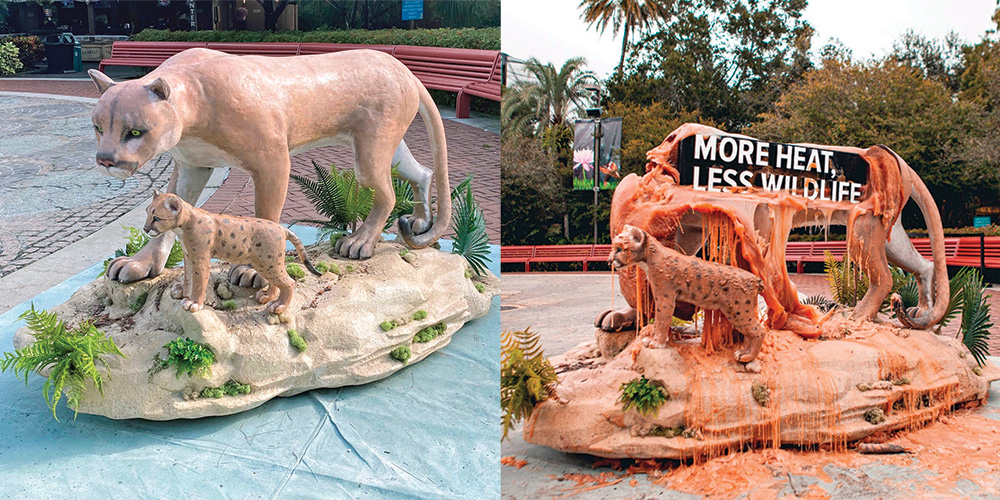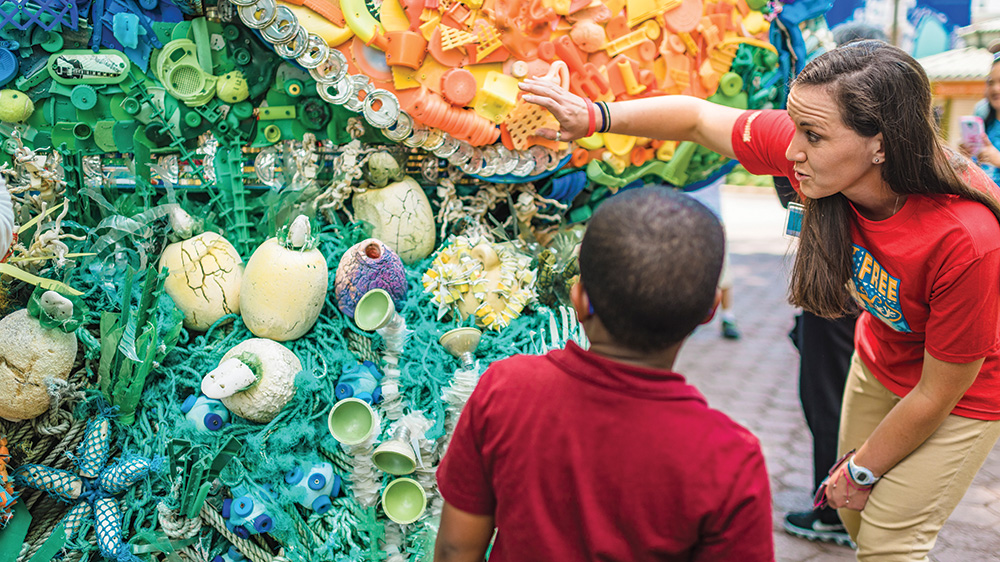Strategy 2: Engage and Educate Across Diverse Communities
Over the past decade, American society has made progress in public understanding of and engagement with climate change. It is no longer just discussed by scientists, but across whole communities—in churches, through civic organizations, and at the family dinner table. K–12 educators are increasingly teaching climate science, supported by climate-friendly curricula such as the Next Generation Science Standards.32 The media has largely abandoned debating whether humans cause climate change and embraced coverage of climate issues in news and weather.33 As a result of these efforts, a record number of Americans both accept the scientific evidence for climate change and feel empowered to act.34
Yet debate around climate change continues. Some aspects of these debates are genuinely contentious, such as how to share the burden of action equitably, but other controversies result from ineffective communication strategies or misinformation campaigns. While education can be an effective intervention, there remain inconsistencies in climate curricula across the country.
Decades of community outreach and education, as well as communication research, have created a roadmap for strengthening climate engagement, but barriers to implementation remain.35 The recommendations here focus on expanding the number of credible climate voices, celebrating concrete commitments to climate action, and combatting misinformation. An improved strategy for communication must also offer educators broader curricula that focus not just on climate science, but on how society manages climate-related challenges and opportunities.
2.1 Empower diverse and trusted messengers to communicate climate change issues that resonate with specific communities.
The United States comprises a host of diverse communities based on location, political affiliation, race, socioeconomic status, faith, and other identities—and these communities tend to view climate issues in dramatically different ways. For example, communities that live close to coastlines may associate climate change with observable coastal erosion, while inland communities may worry about climate-related flooding.36 There is now an emerging body of research, including the Proven Principles of Effective Climate Change Communication paper put out by this Commission, that seeks to improve climate messaging strategies.37 Communities engage most effectively with climate issues that reflect their values, such as the protection of public health, conservation, or being a good steward for creation. Communicating well not only helps reach broader audiences but strengthens social cohesion, which improves mental health and better prepares communities to adapt and build resilience.
Communicating climate change has historically been done by scientists and experts who some communities perceive as elite and respond poorly to. For this reason, empowering messengers and trusted leaders from various communities can be more persuasive, especially for reaching skeptical populations. For example, advertising campaigns from New Climate Voices, a group of conservatives focused on effecting climate action by appealing to economic growth, national security, and other issues typically prioritized by conservatives, have successfully increased Republican understanding of climate change.38
Encouraging scientists to emphasize other parts of their identities also facilitates effective communication. For example, the group Science Moms puts a spotlight on climate scientists who are also mothers.39 Communicating about climate issues by emphasizing concern for children’s well-being frames the issue in a way that engages and motivates mothers.
Research has also shown that the most effective communication does not come from sharing scientific knowledge, but through messages targeting emotion, morality, and the human spirit.40 Art, music, and poetry help people understand climate change, connect with the issue emotionally, and take action. For example, the Miami-based CLEO Institute (Climate Leadership Engagement Opportunities) created sculptures of iconic Florida symbols that melted in temperatures above 90 degrees Fahrenheit, raising awareness of the impact extreme heat will have on quality of life in the state.
Framing climate issues in personally relevant and less abstract ways also makes it easier to engage diverse communities. Finding the messengers that resonate with audiences is key to successful messaging. For example, the Hip Hop Caucus uses the visibility of popular musical artists to spread climate information, while the organization Good Energy consults on engaging ways to integrate climate issues in TV and film.41 Medical professionals such as nurses and physicians, who remain two of the most trusted professionals, can emphasize the extent of harmful health effects from climate change and the health benefits of many climate solutions.42
Cultural context varies enormously and has a significant impact on communication. For example, the Indochinese Cultural and Service Center considered intergenerational knowledge transfer while communicating with their community about climate issues. Because elders in many Asian/Pacific Islander communities are more likely to listen to their grandchildren than their adult children, they focused on educating the youth on climate issues to spread climate information most effectively throughout the entire community.43
Many of these examples have been funded by philanthropy. For philanthropists seeking to make an impact on climate change, supporting these authentic messengers is a highly effective way to spend resources.
Evangelical Environmental Network: Mobilizing Religious Groups for Climate Action
Communicating climate through values that resonate with different populations is key to building a diverse coalition. Churches and other religious institutions have the power to gather a wide range of people and are often cornerstones in local cultures and communities. Spreading climate information and encouraging engagement in these settings are powerful tools for accelerating climate action.
Traditional climate messaging is rarely successful with more conservative audiences and, as a result, evangelical Americans are less likely to express concern over climate change than the overall American population.44 The Evangelical Environmental Network (EEN), led by Reverend Mitchell Hescox, is a nonprofit organization whose mission is to rewrite this relationship by educating and mobilizing evangelical Christians to advocate for climate action.45 The EEN emphasizes Christian responsibility for “creation care,” or the act of caring for all of God’s creations by preventing harmful activities, including those that contribute to climate change.
The EEN provides a variety of resources to help churches and individuals take climate action, including webinars, workbooks, and written materials. Additionally, they have led a campaign focused on how air and water pollution harm unborn children, a key concern for many members. The EEN also runs education initiatives about other key issues, including methane pollution and the protection of public lands. The EEN’s efforts have successfully mobilized conservatives to support federal policies, including Mercury and Air Toxics Standards and the Inflation Reduction Act, as well as other actions to ensure clean energy, pristine air, and pure water.
2.2 Support and celebrate concrete commitments to climate action by government, businesses, community groups, and NGOs.
As organizations and governments reduce emissions, public communication about their specific actions can build accountability and inspire others to follow their example. This public communication often takes the form of climate action plans, which detail current emissions and strategies for emissions reduction and improving climate resiliency. Existing initiatives such as the Global Covenant of Mayors for Climate and Energy have inspired the formation of new climate action plans.46
While celebrating climate action can pressure other corporations to act themselves, these actions must include timelines, monitoring, and accountability. Tools, training, and procedures, such as those provided by the Greenhouse Gas Protocol, currently exist to help corporations and governments quantify and manage their emissions and allow for more accurate carbon footprint disclosure.47 Organizations such as Stand.earth and 350.org also track and make publicly available records of these commitments in the Global Fossil Fuel Divestment Commitments Database to increase accountability.48
2.4 Expand access to climate education across K–16 subjects and into formal and informal education venues. Advocate for climate education in all state curricula and develop tools for knowledge assessment.
The country’s increased engagement on climate change will be easier to sustain over the long term if more Americans have access to climate change education. To that end, sustained climate engagement requires education at the K–12 through university levels, and informally through community outreach, adult education, broadcast science series, museums, and science fairs. Climate science should be incorporated into state curricula and assessments and rooted in known techniques for instruction.63
Advocate for adopting climate standards during state education standards reviews to create lesson plans that incorporate climate learning across subjects.
In the United States, the quality of K–12 climate change education varies from state to state.64 Some states, such as Wyoming, clearly teach anthropogenic climate change across all grades, while others, such as Pennsylvania, do not mention climate change in their standards. However, even in comprehensive frameworks, most climate discussion centers on traditional frames, such as conservation or fossil fuel reduction, instead of adaptation, Indigenous Knowledge, and environmental justice. Further, less than 50 percent of social studies and 5 percent of language arts standards discuss climate change.65 Adequately preparing students for the challenges ahead requires an integrative approach that links climate change with civic engagement, media literacy, and justice. States revise their standards every five to twenty years, typically seeking comments from the public and education experts. Parents, who overwhelmingly support teaching climate change in schools, should continue to advocate for revisions that increase climate content in state standards.66
Create and validate a national assessment instrument to measure climate change knowledge in K–12 and university students.
Improving climate education requires assessing and targeting current gaps in student knowledge. However, while there are instruments to assess student attitudes and beliefs about climate change, there are no standard instruments to measure knowledge, as exist for many other complex and controversial science topics (such as evolution, genetics, and vaccines).67 Developing and validating this instrument would improve national monitoring of climate knowledge growth and refine educational approaches to address remaining gaps. Education researchers should make the development of this tool a priority. Educators should use these results to develop curricula that address knowledge gaps and help integrate climate concepts outside the science classroom. Key topics include balancing risks and benefits, political decision-making, and the consequences of inequality.
Fund experiments to design and test new methods for integrating climate across curricula.
Participatory experiences like place-based learning and activities that focus on collective causes and action are effective strategies for climate education. Role-playing games, such as the World Climate Simulation, are particularly effective for strengthening applied climate knowledge.68 School-based projects, such as environmental advocacy or climate action plans, further help students get involved in climate action. While many curricula use these strategies, they often require significant funding and climate knowledge to teach, which amplify existing inequities in education.69 Therefore, an investment must come from the district or state rather than individually motivated teachers.
This experimental approach requires testing new curricula and evaluating which approaches are effective.70 Philanthropy, school boards, and state educational institutions should provide funding for education researchers to test curricular efficacy.
A Role for Informal Science Education
Informal science education outside the traditional school system can be a powerful tool to integrate climate education into different venues, educate people who may not thrive in a structured classroom environment, and extend the reach and audience for climate knowledge. Science fairs, climate weeks, museums, libraries, nature centers, civic organizations such as the Boy Scouts and Girl Scouts of America, and faith groups, including adult study groups, Sunday schools, Hebrew schools, and youth groups, all can be effective platforms for climate education. These opportunities allow climate information to reach audiences of all ages and geographic regions, including those where climate change is not adequately taught in the school curriculum.
The Science Festival Alliance highlights science festivals in locales nationwide, from Alabama to Virginia, Colorado, Massachusetts, and California.71 These festivals allow the public to engage with climate science and scientists. They also provide resources for those interested in setting up new community festivals. Collaboration with local museum exhibits and discussions provides additional opportunities for increased exposure to climate change science outside the classroom.
Informal science education opportunities are beneficial because they are often free or available at low cost and are accessible to all ages and a wide range of demographics. However, local views of climate science and policies can sometimes dissuade event and program organizers from implementing informal science education opportunities and programs where access to this information would be most impactful. Framing climate issues in a local context, increasing accessibility of scientific information, ensuring available funding, and forging partnerships and collaborations with experts help overcome these barriers.


